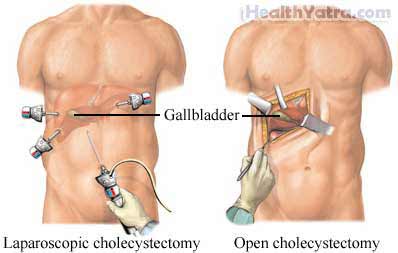تعريف
Cholecystectomy is the surgical removal of the gallbladder. This procedure is most often done laparoscopically. This is done through several small incisions in the abdomen. In some cases, the doctor may switch to open surgery. This involves a large incision in the abdomen.

أسباب هذا الإجراء
This surgery is used to remove a diseased or damaged gallbladder. The damage is often due to gallstones. Sometimes, gallstones get stuck in the gallbladder’s ducts. Bile, which helps with digestion, normally flows through these ducts. The blockage can damage the gallbladder and the liver.
المضاعفات المحتملة
Complications are rare, but no procedure is completely free of risk. If you are planning to have a cholecystectomy, your doctor will review a list of possible complications, which may include:
- Gallstones that have accidentally spilled into the abdominal cavity
- نزيف
- العدوى
- Injury to other nearby structures or organs
- Reactions to general anesthesia
- Blood clots
بعض العوامل التي قد تزيد من خطر المضاعفات تشمل:
- العمر: 60 سنة أو أكثر
- حمل
- السمنة
- التدخين
- سوء التغذية
- مرض مزمن أو حديث
- مرض السكري
- مشاكل في القلب أو الرئة
- اضطرابات النزيف
- Alcoholism and use of street drugs
- Use of certain medicines
ما يمكن توقعه
قبل الإجراء
Your doctor will probably do some or all of the following:
- Blood tests to evaluate liver function
- Ultrasound to visualize gallstones
- HIDA scan—an x-ray test that uses a chemical injected into the gallbladder to create pictures the gallbladder and surrounding area
- EKG and chest x-ray —to make sure that the heart and lungs are healthy enough for surgery
- Other radiological scans
المؤدية إلى الإجراء الخاص بك:
- تحدث إلى طبيبك عن أدويتك الحالية. قد تحتاج بعض الأدوية إلى التوقف قبل الإجراء ، مثل:
- الأسبرين أو غيره من الأدوية المضادة للالتهابات لمدة تصل إلى أسبوع قبل الجراحة
- أدوية تسييل الدم ، مثل الوارفارين (الكومادين)
- كلوبيدوجريل (بلافيكس)
- Arrange for a ride to and from the procedure. Also, have someone help you at home.
- في الليلة السابقة ، تناول وجبة خفيفة. لا تأكل أو تشرب أي شيء بعد منتصف الليل.
- قد تحصل على:
- Laxatives and/or an enema
- مضادات حيوية
- If instructed, shower before the procedure.
التخدير
General anesthesia will be used. You will be asleep for the procedure.
الوصف الداخلي
Four small openings will be made in your abdomen. Carbon dioxide will be pumped in to the abdomen to provide a better view.
The laparoscope will be inserted through one of the openings. It will provide images of the gallbladder and surrounding area. Instruments will be inserted through the small openings. They will be used to grasp the gallbladder and clip off the main artery and duct. The gallbladder will be removed through one of the small openings. Dye may be injected into the duct to look for stones. The entire abdomen will be carefully examined. The incisions will be closed with sutures or staples. They will be covered with bandages.
Your doctor may place a tiny, flexible tube into the area. This tube will exit from your abdomen into a little bulb. This is to drain fluid. The tube is usually removed within one week.
مباشرة بعد الإجراء
You will be taken to a recovery room.
كم من الوقت سيستغرق ؟
About 30-60 minutes
كم هو مؤلم ؟
You will have pain after the procedure. Your doctor will give you pain medicine.
متوسط الإقامة في المستشفى
If you do not have any problems, you may be able to go home the same day as the surgery or the next day.
رعاية ما بعد العملية
في المستشفى
After the procedure, the hospital staff will:
- Monitor you for any problems
- Give you medicines for nausea
- Provide you with nutrition through an IV (if you have a tube in your stomach to drain fluid)
- Help you to slowly progress from a liquid diet to soft foods
في البيت
Recovery takes about three weeks. When you return home, do the following to help ensure a smooth recovery:
- اتبع تعليمات طبيبك.
- Also, follow the recommended diet and activity plan.
- اسأل طبيبك حول, عندما هي آمنة للاستحمام, السباحة, أو نقع في الماء.
Your liver will take over the functions of the gallbladder. You may notice that you have more trouble digesting fatty foods, especially during the first month of recovery.
استدعاء الطبيب
بعد مغادرة المستشفى، اتصل بطبيبك في حالة حدوث أي مما يلي:
- علامات الإصابة, بما في ذلك حمى وقشعريرة
- احمرار أو تورم أو ألم متزايد أو نزيف مفرط أو إفرازات في موقع الشق
- سعال وضيق في التنفس وألم في الصدر
- زيادة آلام البطن
- ألم لا يمكنك السيطرة عليه بالأدوية التي أعطيت لك
- Blood in the stool
- Nausea and/or vomiting that you cannot control with the medicines you were given, or which last for more than two days
- Bloating and gas that persist for more than a month
- ألم أو حرقة أو إلحاح أو كثرة التبول أو ظهور دم في البول
- ألم و/أو تورم في قدميك، أو ساقيك، أو ساقيك
- Dark urine, light stools, or evidence of jaundice (yellowing of the skin or eyes)
في حالة الطوارئ ، اتصل على المساعدة الطبية على الفور.
